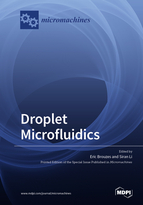Droplet Microfluidics
A special issue of Micromachines (ISSN 2072-666X). This special issue belongs to the section "A:Physics".
Deadline for manuscript submissions: closed (1 September 2020) | Viewed by 37665
Special Issue Editors
Interests: single-cell analysis; single-cell genomics; droplet microfluidics; array of microwells
Special Issues, Collections and Topics in MDPI journals
Interests: single-cell DNA sequencing; single-cell RNA sequencing; cancer genomics; bioinformatics
Special Issue Information
Dear Colleagues,
Droplet microfluidics has dramatically developed in the past decade, and has been established as one of the microfluidic technologies that can translate into commercial products. Its rapid development and adoption have relied not only on an efficient stabilizing system (oil and surfactant), but also on a library of modules that are able to manipulate droplets at a high-throughput. Droplet microfluidics is a vibrant field that keeps evolving, with advances that span technology development and applications. Recent examples include innovative methods to generate droplets, to perform single-cell encapsulation, magnetic extraction, or sorting at an even higher throughput. The trend consists of improving parameters such as robustness, throughput, or ease of use. Remarkably, these developments rely on a firm understanding of the physics and chemistry involved in capillary systems at a small scale. Finally, droplet microfluidics has played a pivotal role in biological applications, such as single-cell genomics or high-throughput microbial screening, and chemical applications.
This Special Issue seeks to showcase all of the aspects of the exciting field of droplet microfluidics, including, but not limited to, technology development, applications, and open-source systems.
Dr. Eric Brouzes
Dr. Siran Li
Guest Editors
Manuscript Submission Information
Manuscripts should be submitted online at www.mdpi.com by registering and logging in to this website. Once you are registered, click here to go to the submission form. Manuscripts can be submitted until the deadline. All submissions that pass pre-check are peer-reviewed. Accepted papers will be published continuously in the journal (as soon as accepted) and will be listed together on the special issue website. Research articles, review articles as well as short communications are invited. For planned papers, a title and short abstract (about 100 words) can be sent to the Editorial Office for announcement on this website.
Submitted manuscripts should not have been published previously, nor be under consideration for publication elsewhere (except conference proceedings papers). All manuscripts are thoroughly refereed through a single-blind peer-review process. A guide for authors and other relevant information for submission of manuscripts is available on the Instructions for Authors page. Micromachines is an international peer-reviewed open access monthly journal published by MDPI.
Please visit the Instructions for Authors page before submitting a manuscript. The Article Processing Charge (APC) for publication in this open access journal is 2600 CHF (Swiss Francs). Submitted papers should be well formatted and use good English. Authors may use MDPI's English editing service prior to publication or during author revisions.
Keywords
- droplet microfluidics
- droplet manipulation
- droplet-based applications
- chemistry of microfluidic droplets
- physics of microfluidic droplets
- open-source equipment for droplet microfluidics
- droplet-based high-throughput screening
- single-cell manipulation or analysis with droplet microfluidics
Related Special Issue
- Droplet Microfluidics, Volume II in Micromachines (1 article)







